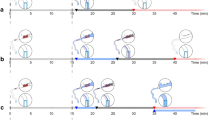Abstract
Previously, we observed that reducing myocardial temperature in the risk region before coronary artery occlusion caused a profound reduction in infarct size. It is unknown whether lowering myocardial temperature after ischemia has already begun, or just before reperfusion, is also effective in reducing infarct size. This study tests the hypothesis that reducing myocardial temperature locally, after coronary occlusion, reduces infarct size.Methods: Anesthetized rabbits received 30 min of coronary artery occlusion and three hours of reperfusion. Myocardial temperature in the risk zone was monitored. Rabbits were randomly assigned to one of three groups: group 1, topical myocardial cooling starting 10 min after coronary occlusion (n=11); group 2, cooling starting 25 min after coronary occlusion (n=11); or group 3, control, no intervention (n=10).Results: Hemodynamic parameters and regional myocardial blood flow were equivalent in all groups. Risk zone temperature was similar in all groups at occlusion. The cooling maneuver produced a rapid reduction in temperature in the risk region. In group 1, myocardial temperature was reduced an average of 6.3°C between 10 and 15 min of coronary artery occlusion; myocardial temperature in group 2 was reduced an average of 5.9°C between 25 and 30 min of coronary artery occlusion. Cooling was maintained until 15 min of reperfusion. Myocardial temperature in group 3 remained within 0.3°C of baseline during coronary artery occlusion and into reperfusion. Core temperature was similar in all groups. Although the ischemic risk region was comparable in all groups, early cooling (group 1) resulted in a significant reduction in infarct size, expressed as a fraction of the risk region, compared with the control group (0.23±0.04 vs. 0.44±0.04 of the risk region); however, cooling just before reperfusion (group 2) failed to modify infarct size compared with the controls (0.43±0.04 and 0.44±0.04 of the risk region, respectively).Conclusion: These results support our hypothesis that reducing myocardial temperature reduces infarct size. However, it is important the reduction in temperature be produced as early as possible following coronary artery occlusion.
Similar content being viewed by others
References
Abendschein DR, Tacker WA, Babbs CF (1978) Protection of ischemic myocardium by whole-body hypothermia after coronary artery occlusion in dogs. Am Heart J 96: 772–780
Chien GL, Wolff RA, Davis RF, Van Winkle DM (1994) “Normothermic range” temperature affects myocardial infarct size. Cardiovasc Res 28: 1014–1017
Duncker DJ, Klassen CL, Ishibashi Y, Herrlinger SH, Pavek TJ, Bache RJ (1996) Effect of temperature on myocardial infarction in swine. Am J Physiol 270: H1189-H1199
Hale SL, Kloner RA (1997) Myocardial temperature in acute myocardial infarction: protection with mild regional hypothermia. Am J Physiol 273: H220-H227
Heyman MA, Payne BD, Hoffman JIE, Rudolph AM (1977) Blood flow measurements with radionuclide-labeled particles. Prog Cardiovasc Dis 20: 55–79
Meerbaum SM, Haendchen RV, Corday E, Povzhitkov M, Fishbein MC, Y-Rit J, Lang T-W, Uchiyama T, Aosaki N, Broffman J (1982) Hypothermic coronary venous phased retroperfusion: A closed-chest treatment of acute regional myocardial ischemia. Circulation 65: 1435–1445
Position of the American Heart Association on research animal use (1985) Circulation 71: 849A–850A
Verbinski SG, Schwartz LM, Vander Heide RS, Reimer KA (1995) Minor variation in pericardial temperature is a major predictor of infarct size in dogs (abstract). Circulation 92 [Suppl]: I-457
Wakida Y, Haendchen RV, Kobayashi S, Nordlander R, Corday E (1991) Percutaneous cooling of ischemic myocardium by hypothermic retroperfusion of autologous arterial blood: effects on regional myocardial temperature distribution and infarct size. J Am Coll Cardiol 18: 293–300
Author information
Authors and Affiliations
Corresponding author
Rights and permissions
About this article
Cite this article
Hale, S.L., Dave, R.H. & Kloner, R.A. Regional hypothermia reduces myocardial necrosis even when instituted after the onset of ischemia. Basic Res Cardiol 92, 351–357 (1997). https://doi.org/10.1007/BF00788947
Received:
Revised:
Accepted:
Issue Date:
DOI: https://doi.org/10.1007/BF00788947




